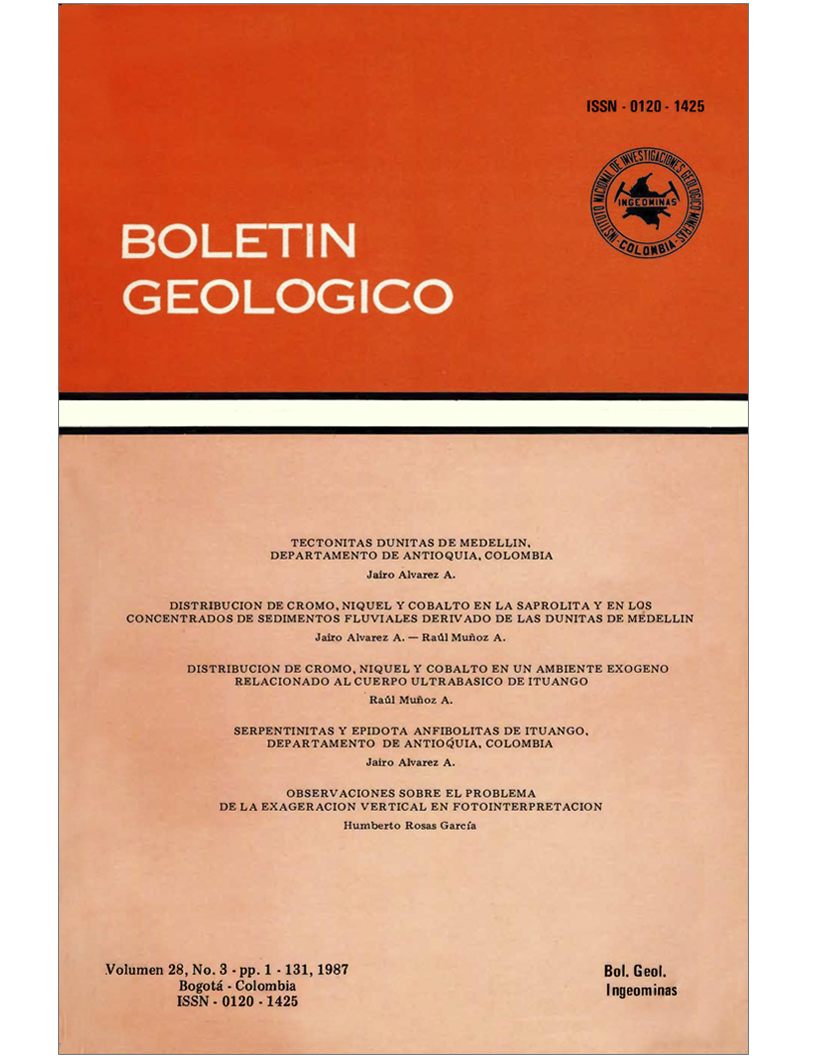Serpentinites and epidote amphibolites from Ituango, department of Antioquia, Colombia
DOI:
https://doi.org/10.32685/0120-1425/bolgeol28.3.1987.329Keywords:
Ultramafite, Valdivia group, Paleozoic, harzburgite, ophiolitic, toleitic compositionLicense
Copyright (c) 1987 Servicio Geológico Colombiano

This work is licensed under a Creative Commons Attribution 4.0 International License.
Downloads
How to Cite
Issue
Section
Published
Abstract
The serpentinites and epidote-amphibolites of the Ituango area form a discontinuous body, very long and thin, north-south trending, and 35 km long, which is part of the mafic-ultramafic belt, alpine type, related to the Romeral tectonic zone. This body is embedded within a folded eugeosynclinal sequence (Valdivia Group), with low-grade e metamorphism and possibly Paleozoic age. The lithotypes that form it have tectonic contact with each other and with the encasing metamorphic rocks.
The sepentinite, sheared and internally fractured, consists of antigorite and/or lizardite and chrysotile. It has a MgO/MgO + FeO* ratio between 0.82 and 0.85 and MgO/SiO2 between 0.92 and 1.07, suggesting that serpentinization was an isochemical process, accompanied only by the addition of water and that the protolith was mainly a harzburgite. The relict chemical and mineralogical characteristics hint that this rock was a residue of partial melting in the mantle.
Gneissic and schistose epidote-amphibolites differing in mineralogy, degree of recrystallization, and shearing were distinguished; they are gradational from each other, the second type predominating towards the base of the ophiolitic thrust. The chemical composition of these rocks follows the toleiitic trend, is like that of the dredged intermediate gabbros of the Atlantic ridge and is in the field of high-Ti ophiolites. The protolith was, perhaps, a slightly magnesium-rich homogeneous gabbro generated in a marginal Basin ridge.
In the Late Cretaceous-Early Tertiary, the Ituango body was emplaced solidly, like a dismembered ophiolitic fragment along deep east-dipping reverse faults. During emplacement, the rocks were recrystallized and penetratively deformed. The emplacement at the present level is post-Early Miocene and continues today because of the active movement of the faults bounding these rocks.
References
ÁLVAREZ, J. et al, 1970.- Mapa geológico del cuadrángulo H-8 (Yarumal) y parte este del cuadrángulo H-7 (Ituango). Escala 1:100.000. Ingeominas. Bogotá.
ÁLVAREZ, J. et al, 1979.- Geología de la Cordillera Central y el Occidente Colombiano y petroquímica de los intrusivos granitoides mesocenozoicos. Santiago de Chile. Universidad de Chile. Tesis de doctorado, 359 p.
ÁLVAREZ, J. et al, 1981.- Serpentinitas y metagabros relacionados del área de Ituango, Departamento de Antioquia, Colombia. Resumen Tercer Congreso Colombiano de Geología. Medellín.
ÁLVAREZ, J. et al, 1982.- Tectonitas dunitas de Medellín, Departamento-de Antioquia, Colombia. Informe 1896. Ingeominas, 62 p. Medellín.
BARRERO D., ÁLVAREZ, J., KASSEM, T., 1969.- Actividad ígnea y tectónica en la Cordillera Central durante el Mesocenozoico. lngeominas, Bol. Geol. 18 (1-3): 145-173. Bogotá.
BONATTI, E., HONNAREZ, J. and FERRARA, G., 1971.-Peridotite-gabro-basaltcomplex from the Ecuatorial Mid-Atlantic Ridge. Phil. Trans. Roy. Soc. London, A. 268: 385-405.
CASE, J. et al, 1971.- Tectonic Investigations in western of Colombia and eastern Panamá. Geol. Soc. Am. Bull. (Boulder, Colorado), 82 (10): 2686-2711.
COLEMAN, R.G., 1967.- Low temperature Reaction zones and Alpine Ultramafic Rocks of California, Oregon and Washington. Geol. Surv. Prof. Paper·l247, 49 p. Washington.
COLEMAN, R.G., 1971.- Plate tectonic emplacemet of upper mantle peridotites along· continental edges. Jour. Geophys. Res, 76: 1212-1222. Washington.
COLEMAN, R.G., KEITH, T.E., 1971.- A chemical study of serpentinization. Burro Mountain, California. Jour. Petrol. 12 (2): 311-328. Oxford.
DEWEY, J.F., BIRD, J.M., 1971.- Origin and emplacement of the ophiolite suite: Appalachian ophiolites in Newfounland. Jour. Geophys. Res. 76:3179-3206. Washington.
GONZALEZ, H., 1974.- Metamorfismo dinámico en la zona de Falla de Romeral, Colombia. Simposio sobre Ofiolitas, Medellín, 21 p.
GREEN, D.H., 1964.- The petrogenesis· of the high-temperature peridotite intrusion in the Lizard Area, Cornwall. Jour. Petrol. 5: 134-183. Oxford.
HALL, R., ÁLVAREZ, J., RICO, H., 1972.- Geología de los departamentos de Antioquia y Caldas (Sub-Zona JI-A.). lngeominas, Bol. Geol. 20: 85 p. Bogotá.
HESS, H.H., 1955.- Serpentinites Orogeny and Epeirogeny. Geol. Soc. Am. Spec. Paper 62:391-407. Washington.
LONEY, R.A., HIMMELBERG, E.R., COLEMAN, R.G., 1971.- Structure and Petrology of the Alpine type peridotite at Burro Mountain, California. Jour. Petrol. 12: 245-309. Oxford.
MIYASHIRO, A., SHIDO, F., EWING, M., 1970.- Crystallization and differentiation in Abyssal tholeiites and gabbros from mid-oceanic ridges. Earth Planet. Sci. Lett. 7:361-365. Amsterdam.
PENROSE FIELD CONFERENCE, 1972.- Report of conference of ophiolites. Geotime, 17:24-25.
RAASE, P., 1974.- Al and Ti contents of hornblencle. Indicator of pressure and temperature of regional metamorphism. Contr. Miner. Petrol. 45:231-236. Ainsterdam.
SERRI, G., SAITTA, G., 1980.- Fractionation trends of the gabroic complexes from high-Ti and low-Ti ophiolites and the crust of majar oceanic basins: A comparation. Ofioliti, 5 (2-3): 241-264. Bologna.
STERN, C.R., ELTHON, D., 1979.- Vertical variations and the effects of hydrothermal metamorphism in Chilean ophiolites: their implications far ocean-floor metamorphism. Tectonophysics. 55: 179- 213. Amsterdam.
THAYER, T.P., 1967.- Chemical and structural relations of ultramafic and feldspathic rocks in alpine intrusive complexes. in: Ultramafic and Related Roclts. Wyllie, P.J. (ed), Wiley: 222-238. New York.
VINOGRADOV, A.P., 1962.- Average contents of chemical elements in the principal types of igneous rocks of the Earth's Crust. Geochemistry: Vol. 7: 661-664.
WOODWARD CLYDE CONSULTANTS, 1980.- Preliminary Seismic Hazard study, Ituango Project, Colombia. Phase J. 152 p.
YGDER, H.S., Jr. SAHAMA, T.G., 1957.- Olivine X-ray determinative curve. Am. Min. 42: 475-491. Washington.









